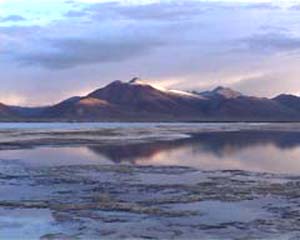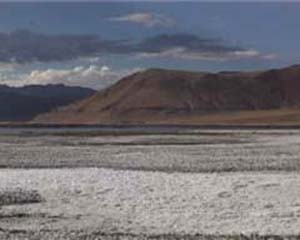Apr 13, 2025
Apr 13, 2025
It appears that birds like bar-headed goose, the great crested grebe, the Brahmin duck and the brown headed gull find the lake water congenial enough to breed there! Well for human beings Tsokar is not a very comfortable place to live in.  In routine life people imagine lakes as if they were the nature's water tubs or giant pools. In reality the lakes are agog with life and have plenty of tales hidden in their depths. The earth scientists and palaeobotanists are able to uncover many of the mystery stories buried in the lakes.
In routine life people imagine lakes as if they were the nature's water tubs or giant pools. In reality the lakes are agog with life and have plenty of tales hidden in their depths. The earth scientists and palaeobotanists are able to uncover many of the mystery stories buried in the lakes.
Recently B. Sekar, Amalava Bhattacharyya and S.K. Bera of Birbal Sahni Institute of Palaeobotany (BSIP), Lucknow brought to light pages from the history of three lakes, viz. Tsokar Lake, Ladakh, J&K, Didwana Lake, Rajasthan and Berijam Lake, Palni Hills Tamilnadu and published their work in the volume of Diamond Jubilee International Conference held at BSIP in November, 2006. These lakes are located in three diverse geographical and climatic set ups of our country.
 Tsokar Lake falls in cold, arid climate of Ladakh. This area is cold desert. Tsokar is photographer's paradise. Nadav Harel a film director and cinematographer and Enat Sidi, film editor from Israel visited Tsokar Lake in July 2006. In their photo-feature they inform that it is also called "White Lake" because of the salt deposited all around it-since there is no outlet from the lake which makes the water brackish. Salinity of the lake is so high that salt taken from the banks is sold by the local nomads as "Rupshu Chang", all over Ladakh and Kashmir.
Tsokar Lake falls in cold, arid climate of Ladakh. This area is cold desert. Tsokar is photographer's paradise. Nadav Harel a film director and cinematographer and Enat Sidi, film editor from Israel visited Tsokar Lake in July 2006. In their photo-feature they inform that it is also called "White Lake" because of the salt deposited all around it-since there is no outlet from the lake which makes the water brackish. Salinity of the lake is so high that salt taken from the banks is sold by the local nomads as "Rupshu Chang", all over Ladakh and Kashmir.
Didwana Lake being in Rajasthan falls in the desert and faces an arid climate. Lakes preserve the climatic records. Water has always fascinated mankind and often remnants of old civilizations are found on the banks of lakes. Didwana is also a Paleolithic site and archaeologists have reported palaeoclimatic fluctuations coinciding with changes in cultural stages. Didwana Lake is famous amongst zoologists for its Phytoplankton content. Phyto in Greek means a plant and Plankton means drifting. In reality these drifting plants are tiny and what one sees of them is only a green patch on the surface of water body. Green color is due to their chlorophyll content. Phyto-planktons are invaluable for us. They are responsible for about 98% of oxygen in the Earth's atmosphere says the Wikipedia.
Berijam Lake near Kodaikanal in south India was a swamp discovered by the British and Spanish travelers and till about a century ago. It was converted in to a beautiful lake with the help of micro-watershed development. The lake water quality is excellent and is used for water supply to the nearby town of Periyakulum.
These lakes located in diverse environmental conditions have revealed many more interesting facts. B.Seker and his colleagues plotted radiometric dates obtained from carbon isotopes (14 C) from the sediments of the three lakes against depths. It was found that rate of sedimentation for Tsokar was around 9.5 cm/100 years, for Didwana it came to be 3.9 cm/100 years and for Berijam Lake 2.9 cm/100 years. The organic contents of these lakes on the other hand were found to be 1-95, 6-18% and 5.5-41.8% respectively for Tsokar, Didwana and Berijam lakes. This shows that the rate of sedimentation in these lakes is indirectly proportional to the influx of organic matter.
These authors attribute the high rate of sedimentation in Tsokar Lake to the dry climate largely in the past 30,000 years (ka). Of course in between there was a period of greater melting of ice due to rise in temperatures, which too was responsible for higher influx of material into the lake.
Compared to Tsokar, Didwana Lake catchments had more congenial climate with stable land conditions all around. However, during 8.1ka to 6.3 ka and 4.6 ka to 2.0 ka landforms were unstable and the climate was dry and arid. That was the time when maximum influx of sediments took place in the lake.
Berijam Lake had the most stable land conditions, thus erosion was less and naturally the lake received less sediment but more organic matter during the last 17.7 ka.
As per the evidences gathered by M.D. Kajale and B.C. Deotare of Deccan College, Postgraduate Research Institute, Pune the history of salinity of Didwana Lake from 20000 to 13000 years before present (BP) and 9000 to 6000 years BP shows great climatic fluctuations. They found Didwana Lake to be highly saline in the earlier period and became a freshwater lake during the later period. Hypersalinity in the earlier period coincides with the last glacial maxima, i.e. approximately 18000 BP. The cooling effect of glaciers weakened the monsoon which reduced recharge of the lake and salinity increased. But in later periods approximately 4000 years BP once again a weak monsoon made the lake saline.
The sediments deposited in the lakes carry the history of past climates and hydrology both. Changes in water level, water chemistry and rate of sedimentation all are controlled by the climate. A dry phase of climate means dessication and shrinkage of the lake. It can lead to salinity too. A wet climate leads to a lake filled with water, more vegetation around. The pollen of steppe type of vegetation has been reported by M.D. Kajale and his co-workers.
Most of the lakes, of India barring few of the inhospitable terrains, have evidences of past settlements. Water bodies are important because the rising need for water in the light of bursting population. P.C. Tzedakis of Cambrige University, Cambridge, U.K. researched on the climate changes from the drill cores of northeastern Greece. He made detailed observations on the climate and vegetation from the cyclic glacial and inter-glacial sedimentary deposits of the past 1.75 million years. Based on the appearance of certain plant species and disappearance of others he has been able to identify inter-glacial periods. During the past 1.75 million years, barring the last 10000 years, rest were cold days even for our country. It was only during inter-glacial periods the life thrived.
Thus what the palaeobotanists, geologists and archaeologists are trying to achieve through the study of pollens and vegetable matter, sediments, chronology of pre-historic habitations a complete picture of the past climates. Till now it has been possible to infer climatic changes on millennium and decadal scale. It is seen that as far as the climate is considered study of changes on a millennium scale is significant, because the climate does not change overnight. However, when it comes to human beings the decadal scale has its own importance because changes if any noticed, help the countries planners to visualize possible impacts on crops and ultimately on the society.
Academics apart, it is more significant and vital to save the water bodies, because we have already polluted our rivers and groundwater to maximum of our ability. Only the surface water bodies like lakes are somewhat left untouched. It is time to seriously ponder upon various ways to save them from extinction.
19-Aug-2007
More by : V. K. Joshi (Bijji)